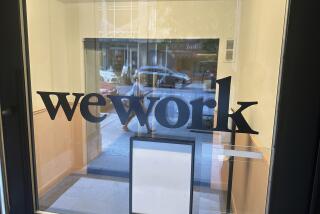Thinking Young : Carter Hawley Hale’s Recovery Strategy Targets New Generation of Shoppers
- Share via
Like the debutante introduced to society for the first time, the emphasis at the new Carter Hawley Hale Stores--set to emerge Thursday from bankruptcy court--will be on youth.
The reorganized department store chain is remodeling stores and revamping its stock, merchandise displays and advertising strategies in a bid to attract more free-spending young people.
Some strategic changes were to be expected from a company emerging from Chapter 11 proceedings, but circumstances beyond Carter Hawley’s control cast a shadow over any internal makeover.
For retailers in Southern California, the overriding issue is the economy. And by most measures, it’s a dismal picture. Things were beginning to turn sour in February, 1991, when slow consumer spending helped push Los Angeles-based Carter Hawley, parent of the Broadway, to seek court protection from creditors.
In the intervening months, unemployment in California--the location of 73 of Carter Hawley’s 87 stores--has been arching above the national average as thousands of jobs vanished from the defense sector and other industries. The jobless rate stood at 9.4% last month, up from 7.8% 20 months ago. Consumer confidence has sunk to new lows, leaving retailers with lots of worried workers preferring to window shop, saving their dollars in case a pink slip lands in their laps.
Carter Hawley is confident that its new strategy will buoy the company during turbulent times. It has not made a profit since filing for bankruptcy, but losses have narrowed in recent quarters. Still, executives are cautious about the prospects of a quick sales surge.
“We think Carter Hawley Hale has a wonderful franchise with great locations and great long-term prospects,” said Sam Zell, chairman of the Zell/Chilmark Fund, the Chicago investment partnership that now owns most of the department store company. “The economy is tough, but we’re not short-term investors.”
No matter what Carter Hawley does, “the California economy will dictate how well the company does,” said Barbara Wedelstaedt, an analyst at the Chicago-based Duff & Phelps investment firm.
Analysts are divided on whether Carter Hawley’s youth strategy will pay off.
The company’s goal is to attract more customers in the 25- to 35-year-old range. Shoppers aged 35 to 60 now account for most customers at its Broadway, Weinstocks and Emporium department stores.
To tilt the mix more toward youth, the retailer is expanding its selection of trendy fashions. For example, items such as silk shirts and blouses--priced in the $38 to $69 range--have been hot-sellers among the younger set, the company said.
The Broadway’s young customers also like garments bearing the labels of Carole Little and Guess. And younger buyers tend to favor clothing designed in Southern California. For that reason, Carter Hawley says it plans to do business with a wider variety of Southland designers.
Carter Hawley is also developing more fashionable ways to display garments and other goods.
The company said new displays will bring more “life, excitement and convenience” to Broadway stores. The displays will also be designed to help buyers of all ages more easily find the desired color, fabric and style.
Wedelstaedt said some of Carter Hawley displays are overdue for the planned changes. But, she said, the company should initially concentrate more on their older customers.
“They have to shore up the loyalty of their existing customer base,” she said. “Going after younger buyers will help them long-term, but they won’t see a return on money spent to attract young shoppers for a while.”
However, industry analyst Walter Loeb of the New York-based Loeb Associates said Carter Hawley is wise to make a rush for the younger market.
“This goal is very correct, but it will also be very difficult to achieve,” Loeb said.
Loeb said Carter Hawley will have more success attracting younger buyers if it more frequently changes its displays. Frequent display changes give buyers the impression that a retailer is closer to the cutting edge of fashion, he said.
While Carter Hawley has contracted with new designers, hired some new buyers to purchase goods and consolidated middle management, there has been little change in top management. Philip Hawley remains chairman and chief executive, and industry analysts give him mixed reviews.
Said Loeb: “I think that Phil Hawley has surrounded himself with a number of talented people and I’m sure he views this as a successful emergence from bankruptcy. However, ultimately, management of day-to-day operations will have to be handled by younger, dynamic people who know the young people’s market.”
Hawley’s future at the company remains uncertain. He declined to be interviewed, saying he wants to focus his attention on the company.
Clearly, a key to Carter Hawley’s future and its emergence from bankruptcy on more solid ground is the paring of its debt load.
Zell/Chilmark relieved the choke-hold by assuming more than a third of the company’s debt. The Chicago investment group on Thursday will make an additional $50-million investment in Carter Hawley. In exchange for the investment and assumption of debt, Zell/Chilmark will get 75% ownership in Carter Hawley.
Sam Zell said Carter Hawley’s planned store modernization is an important part of its revitalization strategy. Carter Hawley plans to remodel 12 to 15 stores per year over the next five years--at an annual cost of between $75 million to $85 million. Store managers believe that those changes will enable them to allocate more space to more profitable departments, such as clothing sections for large and petite shoppers, said Len Benson, manager of the Broadway Galleria store in Glendale.
Carter Hawley also tried to help stores the last two years by expanding the sales floor force by about 800. In Benson’s case, that meant an increase in the Broadway Galleria sales staff from 275 to 300.
“This helps us stand out from the competition,” Benson said. “It shows we don’t believe in long check-out lines. . . . We have to create a happy and convenient shopping experience. We also have to create excitement to bring more people into the store.”
Carter Hawley Hale
When Carter Hawley Hale Stores emerge from Chapter 11 bankruptcy on Thursday, it will--in some respects--be a very different company from the firm that filed for Chapter 11 protection in February, 1991. Changes in organizational structure and product distribution occurred after the bankruptcy filing. Other changes will be effective on Thursday.
Old Carter Hawley Hale
(Before bankruptcy filing)
* Ownership: 40% of the stock owned by CHH employees through a profit-sharing plan and 60% owned by public shareholders.
* Debt: About $1.6 billion.
* Shareholder equity: Minus $554.3 million. (The total is based on company assets minus liabilities.)
* Chief lender: Chemical Bank.
* Organization: Company made up of four divisions--Emporium, Weinstocks, Broadway Southwest and Broadway of Southern California.
* Product distribution: Four separate product purchasing operations--one for each division.
New Carter Hawley Hale
* Ownership: Public shareholders and employees own 7%; Zell/Chilmark Fund investment group owns 75%; unsecured creditors own 18%.
* Debt: About $1 billion.
* Shareholder equity: $350 million.
* Chief lender: General Electric Capital Corp.
* Organization: Management consolidated into one unit called Carter Hawley Hale Stores Inc.
* Product distribution: Centralized buying operation supported by new distribution system responsible for allocation of merchandise to specific stores. This allows the company to meet the customer demands of specific communities.
CARTER HAWLEY’S FINANCIAL TRACK
Carter Hawley Hale Stores have reported losses every financial quarter since filing for Chapter 11 bankruptcy protection on Feb. 11, 1991.
Sales by quarter: Fiscal 1990: 4th quarter: $752.3 million Fiscal 1991: 1st quarter: $430.1 million 2nd quarter: $495.8 million 3rd quarter: $508.7 million 4th quarter: $693.3 million Fiscal 1992: 1st quarter: $433.6 million 2nd quarter: $481.3 million Loss by quarter: Fiscal 1990: 4th quarter: $ 72.7 million loss Fiscal 1991: 1st quarter: $ 32.4 million loss 2nd quarter: $ 35.3 million loss 3rd quarter: $ 16.9 million loss 4th quarter: $102.4 million loss Fiscal 1992: 1st quarter: $ 20.4 million loss 2nd quarter: $ 14.6 million loss Source: Carter Hawley Hale Stores
More to Read
Inside the business of entertainment
The Wide Shot brings you news, analysis and insights on everything from streaming wars to production — and what it all means for the future.
You may occasionally receive promotional content from the Los Angeles Times.










